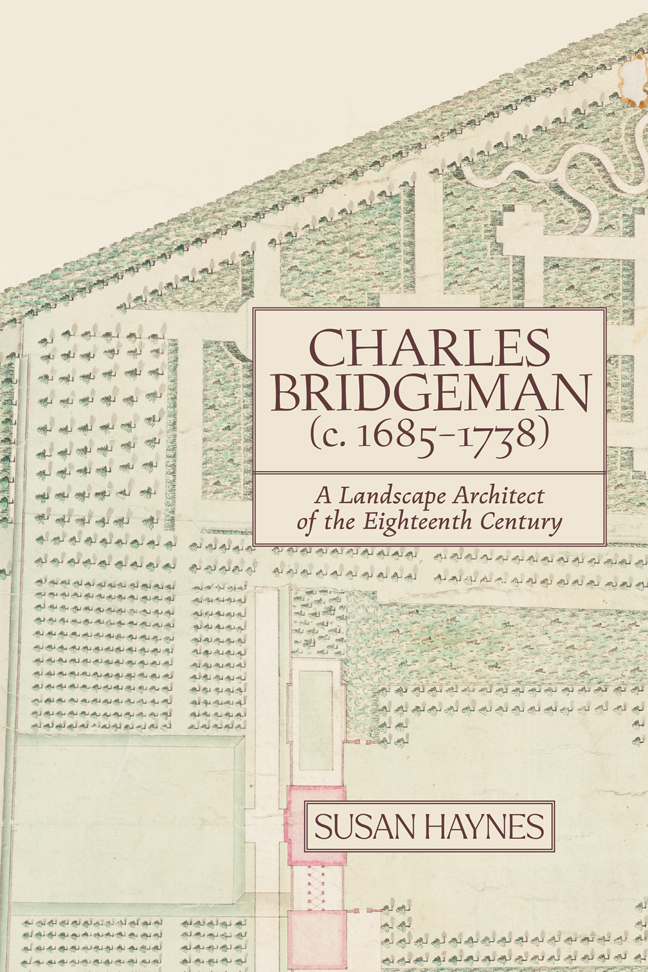Book contents
- Frontmatter
- Dedication
- Maps
- Contents
- List of Illustrations
- Acknowledgements
- List of Abbreviations
- Introduction
- Chapter 1 Who Was Charles Bridgeman?
- Chapter 2 Towards A Reliable Corpus
- Chapter 3 A Revised Catalogue
- Chapter 4 Reading The Plans
- Chapter 5 The Art-Historical Context Revisited
- Chapter 6 The ‘Ingenious Mr Bridgeman’
- Chapter 7 Building a Landscape
- Chapter 8 A Commercial Enterprise
- Conclusion
- Appendix I A summary of Willis's catalogue from Charles Bridgeman and the English Landscape Garden
- Appendix II A revised catalogue
- Appendix III Bridgeman's projects by year
- Appendix IV Bridgeman's income
- Gazetteer of Bridgeman sites
- Glossary
- Bibliography
- Index
- Miscellaneous Endmatter
Chapter 2 - Towards A Reliable Corpus
Published online by Cambridge University Press: 21 February 2024
- Frontmatter
- Dedication
- Maps
- Contents
- List of Illustrations
- Acknowledgements
- List of Abbreviations
- Introduction
- Chapter 1 Who Was Charles Bridgeman?
- Chapter 2 Towards A Reliable Corpus
- Chapter 3 A Revised Catalogue
- Chapter 4 Reading The Plans
- Chapter 5 The Art-Historical Context Revisited
- Chapter 6 The ‘Ingenious Mr Bridgeman’
- Chapter 7 Building a Landscape
- Chapter 8 A Commercial Enterprise
- Conclusion
- Appendix I A summary of Willis's catalogue from Charles Bridgeman and the English Landscape Garden
- Appendix II A revised catalogue
- Appendix III Bridgeman's projects by year
- Appendix IV Bridgeman's income
- Gazetteer of Bridgeman sites
- Glossary
- Bibliography
- Index
- Miscellaneous Endmatter
Summary
IN CHARLES BRIDGEMAN and the English Landscape Garden (originally published in 1977 and revised in 2002), Peter Willis draws together a collection of plans which he attributes to Bridgeman.They are published as black and white photographs. This form gives us a sense of the size of the body of work, but unrolling the real artefacts in the archives of the institutions where they are held is a much more exciting business. They come in a variety of sizes, colours, media and preservation. Some are bright, pristine watercolours, carefully conserved. Others are barely more than scraps of paper in which ink, pencil and wash jostle with each other. They would be significant even if written texts in which Bridgeman explained his artistic vision and working practices had survived, but in the absence of such documents, they become of crucial importance.
It is perhaps odd that the significance of these drawings has been overlooked. Art-historical scholarship, the discipline that is most closely associated with research in garden design, seems to regard them simply as evidence that Bridgeman worked at a site and of the style of his design. In fact, we can read the plans almost as well as we could if they were written texts. They can be interrogated and their meaning revealed through deconstruction. ‘To deconstruct … is, so to speak, to reverse the imposing tapestry in order to expose to all its unglamorously dishevelled tangle of the threads constituting the well-heeled image it presents to the world’ (Eagleton 1986 cited in Harley 2001, 159). By metaphorically turning over Bridgeman's plans, we can unpick the threads that compose their meaning. The plans are also artefacts; they have a materiality, composed of the paper or parchment of which they were made and the medium used to make the marks on them. As artefacts, they have a provenance, an origin and a subsequent story and a purpose, both one for which they were originally designed and one which might, at any stage, have been renegotiated (Johnson 1996, 187). They also have a language which can be read, composed of the marks made on the paper. Some marks are actually words and numbers, but most are a language of symbols and of decorative features which can nevertheless be read, since they are designed to convey meaning, both overt and implicit.
- Type
- Chapter
- Information
- Charles Bridgeman (c. 1685-1738)A Landscape Architect of the Eighteenth Century, pp. 25 - 44Publisher: Boydell & BrewerPrint publication year: 2023



